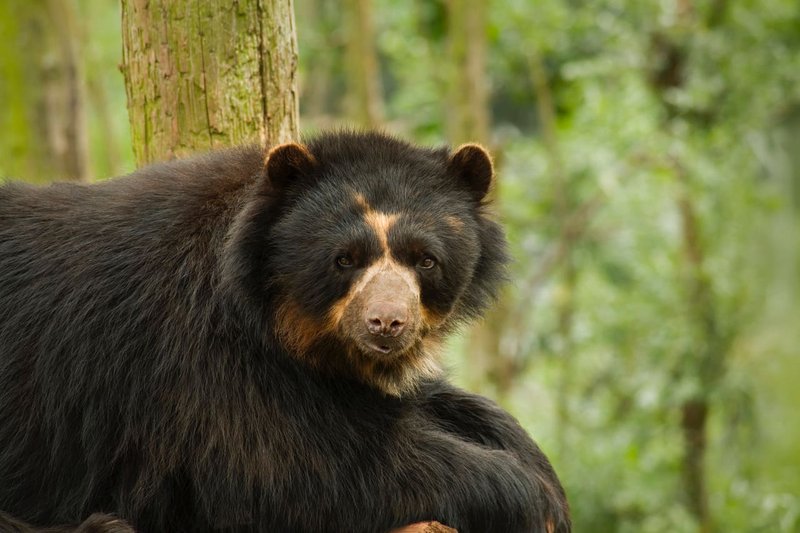
Spectacled bears, also known as the Andean bears, are the only bear species native to South America. Their distribution stretches across various parts of the continent, reflecting both their adaptability and the challenges they face in the wild. If you’ve ever wondered what kinds of environments they thrive in or where you might spot one, you’re in the right place. Let’s explore their habitats, distribution, and the factors that affect where they live.
Understanding the Habitat of Spectacled Bears
When we think about the habitat of the spectacled bear, picture lush forests, towering mountains, and cool, misty highlands. These bears primarily dwell in the Andean cloud forests and montane regions, where the temperatures are milder and there’s plenty of food.
These habitats are characterized by dense vegetation and diverse ecosystems. The bears are excellent climbers, often seen foraging for fruits, leaves, and even insects high up in the trees. The cloud forests provide not only food but also safety from potential predators. Here’s a fun fact: these bears can be picky eaters and primarily consume a plant-based diet, which includes a variety of fruits, flowers, and barks.
The altitude in their habitats varies widely, ranging from about 1,800 to over 4,800 meters above sea level, depending on the specific location within the Andes. This elevation range sets the stage for the diverse microclimates these bears inhabit, allowing them to adapt well to their surroundings.
Geographic Distribution of Spectacled Bears
You might be wondering where exactly these bears can be found. Spectacled bears are primarily located in a few specific countries in South America. Their range stretches from Venezuela in the north to Argentina in the south, with significant populations in countries like Colombia, Ecuador, and Peru.
In Colombia, they can be spotted in several national parks such as Los Nevados and Paramillo, where protection is offered from habitat destruction and poaching. In Ecuador, the Podocarpus National Park is another hotspot, known for its rich biodiversity and as a sanctuary for these bears. When you think about it, these areas serve as critical habitats that help sustain the bear’s population.
While their habitat can vary, one thing remains consistent: they are mostly found in areas with plenty of vegetation and food sources. Unfortunately, as human activity increases in these regions, the bears’ habitat is increasingly threatened.
The Impact of Climate on Spectacled Bears
Climate plays a crucial role in dictating where spectacled bears can thrive. They are sensitive to temperature changes, and their habitat is heavily influenced by the altitude and the weather patterns of the Andes. As the climate warms, the conditions in their mountainous habitats are changing, which can affect their food sources.
The relationship between climate change and wildlife is complex. If temperatures rise, the vegetation may shift, and fruiting seasons could become unpredictable. This situation can make it tougher for spectacular bears to find the food they need. Since they have adapted to a specific range of conditions, they might struggle to move to new habitats.
Interestingly, their ability to climb allows them to find cooler spots as temperatures rise. However, the available trees and vegetation are diminishing due to deforestation. With fewer resources, the bears may find it more challenging to survive, let alone thrive.
Human Impact on Bear Habitats
Humans have a tremendous impact on the habitats of spectacled bears. As urbanization and agriculture expand into the Andean regions, the natural forests that serve as the bears’ homes are shrinking. Deforestation for farming, logging, and infrastructure development disrupts their living spaces and food supplies.
This deforestation not only reduces their habitat but also increases conflicts between bears and humans. Farmers in these areas may see the bears as a threat to their crops, which can lead to attempts at removal or even hunting. While most people appreciate the charm of spectacled bears, the tension between wildlife and human activity can lead to dire consequences for the bears.
Conservation efforts are underway to protect these bears and their habitats, but many challenges remain. Organizations are working to create protected areas and promote sustainable practices that minimize human impacts. It’s a tough battle, but awareness and action can help maintain the delicate balance between human development and wildlife preservation.
Conservation Status and Efforts
According to the IUCN Red List, the spectacled bear is classified as vulnerable. This status highlights the urgent need for conservation efforts focused on both protecting their habitats and raising awareness about their plight.
Several organizations are involved in conservation initiatives, working to establish protected areas and engaging local communities in sustainable practices. They promote eco-tourism, which can provide a financial incentive to protect bear habitats while allowing people to experience these incredible animals up close.
Community engagement is key to conservation success. For instance, educating local farmers about the bears’ behavior can minimize conflicts. By helping them understand how to protect their crops without harming the bears, both can coexist peacefully.
You may also come across conservation groups that participate in research efforts. Understanding the bears’ behavior, diet, and population dynamics is essential for creating effective conservation strategies.
The future of spectacled bears hangs in the balance, shaped by factors like climate change and human activity. They are unique creatures that require specific habitats to thrive, but as these spaces shrink and change, so do their chances of survival.
Through conservation efforts and community involvement, there’s hope for these remarkable animals. If more people become aware of their struggles and the importance of protecting their habitats, we might just give them a fighting chance. Spectacled bears remind us of the beauty and fragility of our natural world, emphasizing the need for balance between our lives and the wild. Let’s keep the conversation going and champion the causes that protect these incredible bears and their habitats.

